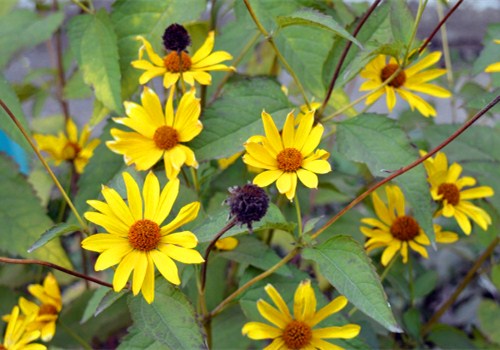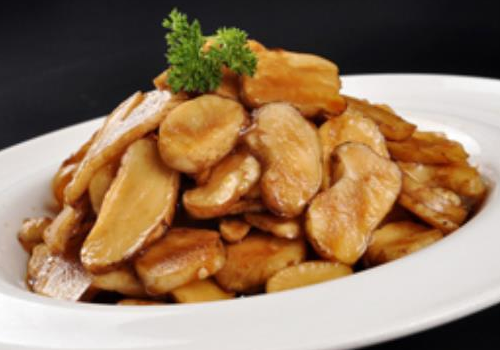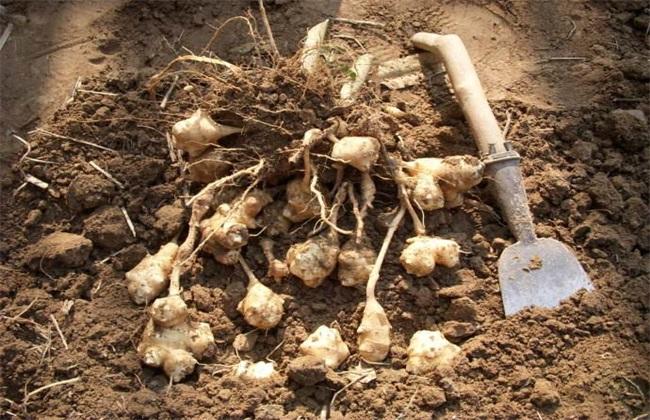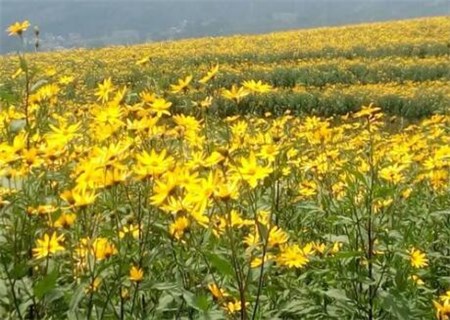also called Jerusalem artichoke Learn more about also called Jerusalem artichoke
-
Jerusalem artichoke (Jerusalem artichoke) planting methods introduced! What are the planting prospects for 2019?

Jerusalem artichoke is also called Jerusalem artichoke, Ginger, Chrysanthemum, Five-star grass, Fanqiang, etc. It is a herb belonging to sunflower genus of Compositae. Its underground stems can not only be eaten, but also used for medicinal purposes. It can also be used as raw materials for starch and alcohol production. So, how does Jerusalem artichoke grow? What are the planting prospects for 2019? Introduction to Jerusalem artichoke!
2019-03-12 -
How to plant Jerusalem artichoke

Because of its excellent cold and drought tolerance, Jerusalem artichoke should not be too picky when choosing soil, despite the choice of wasteland and sandy land. The withered stems and leaves of Jerusalem artichoke can also decompose nutrients and improve soil. After selecting the soil, you can sow seeds at a depth of about 10 centimeters. Weeds should be removed during the seedling period of Jerusalem artichoke.
2018-10-28 -
Is Jerusalem artichoke easy to grow?

Jerusalem artichoke belongs to Compositae, perennial herb, which has high utilization value. Its flowers are still relatively beautiful, with a certain degree of ornamental.
2018-05-04 -
Cultivation techniques of Jerusalem artichoke in North America

North American Jerusalem artichoke, perennial herb, above ground for chrysanthemum, underground for taro, leaves long ovate, head, autumn flowering, tuber fusiform. The yield of stems and leaves per mu is 5000000 kg, with high nutritional value, so it is called high-quality "protein chrysanthemum" and can be used as feed. The yield of tubers per mu is 3000000 kg / mu. It can be used as vegetables, miscellaneous grains, starch and alcohol. Jerusalem artichoke is also a kind of flowers and plants, flowers can beautify the environment. Compared with grain amaranth and rosin grass, which produce stems and leaves alone, it has more function, high value and wide adaptability.
2019-01-11 -
Planting techniques of Jerusalem artichoke

Land preparation: before planting, it is necessary to turn over the land memorial, which is the balance of land nutrition, and the land can be smoothed with a rake. Sowing: seed selection should choose tubers with a quality of more than 30g, disease-free and injury-free, which can be sown in whole or cut. If you cut into pieces and sow seeds
2018-10-28 -
Planting of alpinia officinalis

Artichoke is also called Jerusalem artichoke, its tuber is rich in inulin, fructose poly substance, has a certain auxiliary effect on diabetes, can be pickled slightly spicy when eating. So, what is the cultivation of alpinia officinalis? First, what is the cultivation of ginger? 1. Prepare the seed for
2020-11-08 Alpinia officinarum cultivated also called Jerusalem artichoke its tuber -
How to grow Jerusalem artichoke planting methods and matters needing attention

Jerusalem artichoke is a very common food in our life. Ginger is a planting project that started a long time ago in our country, but most of the planting scale is small, based on meeting the consumption of the family. However, with the efficacy and effect of Jerusalem artichoke,
2020-11-08 Jerusalem artichoke how to plant planting method and matters needing attention -
Can Jerusalem artichoke be planted in the north

It is obvious that there is no difficulty for Jerusalem artichoke to grow artichoke in the north. Jerusalem artichoke is a kind of cold-tolerant and drought-tolerant plant, which can endure 1-2 degrees low temperature and light frost in early spring. After growing up, its mature leaves can withstand a low temperature of minus 5 degrees Celsius. The strongest is actually its stem.
2018-10-28 -
The latest course of Jerusalem artichoke field management techniques and methods

Jerusalem artichoke, also known as artichoke ginger, devil ginger and so on, is a very herbaceous plant with a very large planting area in China. The main use site of Jerusalem artichoke is underground stem, which is rich in starch, inulin and other nutrients, and its market demand is still higher than that of Jerusalem artichoke.
2020-11-10 The latest Jerusalem artichoke field management technology methods tutorials -
How to grow and eat Jerusalem artichoke

There are many ways to make Jerusalem artichoke. Now let's take a look at how artichoke is made. How do you grow Jerusalem artichoke? How to eat: how to plant Jerusalem artichoke: Jerusalem artichoke is a relatively cold-resistant and drought-tolerant plant, which can withstand low temperature. When breeding, pay attention to enough light. When choosing soil, the requirement is not high.
2019-01-21 -
Field management technology of Jerusalem artichoke

Field management technology of Jerusalem artichoke
2019-10-13 -
How to plant the latest Jerusalem artichoke

Jerusalem artichoke is a perennial perennial herb of Compositae. The plant of Jerusalem artichoke is relatively high, but the main edible part is underground tuber. The underground tuber of Jerusalem artichoke is rich in nutrients, with starch, inulin and other polymers. It is used to cook porridge and stir-fry food, and it is also very
2020-11-10 The latest Jerusalem artichoke should how species is belongs to Compositae -
How to plant Jerusalem artichoke

How to plant Jerusalem artichoke
2018-11-16 -
What are the seed planting methods of artichoke (Jerusalem artichoke)? What are the planting prospects? When will it be planted?

Alpinia officinarum is an annual herb of the genus sunflower of Compositae. The ginger is fed by underground tubers. There are sporadic cultivation in various parts of our city, so do you know what are the planting methods of ginger seeds? What are the planting prospects? When will it be planted? In a farmer who grows ginger all the year round, we know that ginger is sown in spring.
2019-03-16 -
Causes of red spot disease of Jerusalem artichoke

In fact, Jerusalem artichoke is tenacious, but reflected in its roots, as long as it is not exposed on the surface of the soil, the soil still has moisture, even if all the flowers and leaves on the ground die, it can still tiller and sprout and be reborn. So in fact, the flowers and leaves of Jerusalem artichoke are also quite fragile, and they will still get sick if they are not properly managed.
2018-10-28 -
How does Jerusalem artichoke prevent erythema

Prevention and control, the focus is first on prevention, to achieve the bacteria strangled in the cradle. This requires us to improve the disease resistance of Jerusalem artichoke, for example: to fertilize Jerusalem artichoke, so that sufficient nutrition under Jerusalem artichoke can grow strong, resistance is also strong. In addition, ventilation and sunlight are essential
2018-10-28 -
Planting techniques of alpinia officinalis

Planting techniques of alpinia officinalis
2018-08-13 -
Cultivation techniques of Jerusalem artichoke

Jerusalem artichoke, alias Yangginger, Guizi ginger, the scientific name helianthustuberosusl., is compositae sunflower annual herbs. Jerusalem artichoke feeds on underground tubers. There are sporadic cultivation in various parts of our city, and the tubers of Jerusalem artichoke are rich in inulin, which is a fructose polymer, which has a certain auxiliary effect on diabetes. The cultivation is extensive and has a development prospect. 1. The botanical characteristic is that the stem is erect and the plant height is 2 to 3 meters. Oblate, with irregular protuberances, underground tubers are irregular
2019-01-15 -
The latest planting method of alpinia officinalis

Alpinia officinarum is a perennial perennial herb, which has a very large planting area in China. The main edible part is the underground rhizome, which can not only be cooked and pickled, but also dried into dried ginger, which is very popular in our country. Alpinia officinalis also has more
2020-11-10 The latest ginger planting method is for many years -
Reproductive habits of Jerusalem artichoke

Crops are generally inseparable from a good soil environment, suitable climate, sufficient water. But Jerusalem artichoke is different. It is not only cold-resistant, drought-resistant and wind-sand-resistant, but also has strong fecundity and strong ability of regeneration. Even if it encounters abnormal extreme weather, the stems and leaves on the ground die, as long as the underground stems are not exposed.
2018-10-28
